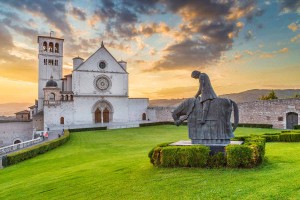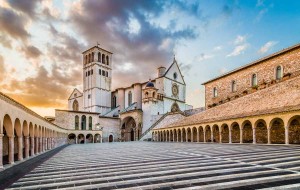
©Bigstock.com/Ibryan
Some World Heritage Sites are dedicated to a certain monument or area. Others deal with an entire epoch or dynasty. And then, there are those focusing on just one single person. The UNESCO united several places from the life of Francis of Assisi under the ominous headline “Assisi, the Basilica of San Francesco and other Franciscan Sites” in 2000. Churches and chapels and the medieval town itself invite you to embark on a foray to the formative years of the Franciscan Order – a brief tour through Umbria in the heart of Italy that is certainly worth your while.
The life of Saint Francis
You’re probably familiar with the name Francis of Assisi. He is one of the most important saints of the Roman Catholic Church, particularly in Central and Southern Europe, and inspired Pope Francis’ papal name in 2013. Francis was born the son of a wealthy clothier in Assisi on the foot of Monte Subasio in 1181 or 1182. He enjoyed excellent education for his class, held many feasts in his youth and originally wanted to become a knight.
While travelling to a battle in Apulia, God appeared to him in a dream making him turn his life around completely. After another epiphany at the cross of the ruinous San Damiano church, Francis decided to live his life in complete poverty for good and started rebuilding the church. He would later gather companions turning into an order after initial resistance: the Franciscans, officially recognised by the pope around 1215. Francis of Assisi died in the Porziuncola church, where his order initially started out, on 3 October 1226. He was canonised less than two years later.
Assisi
Being the saint’s birthplace and home, Assisi is the logical first step of our small tour of this rather extensive UNESCO World Heritage Site. The medieval townscape with its town walls and the ruins of the Rocca Maggiore fortification were named explicitly as points of interest. Indeed, there are several rings of walls running around the historic town centre. Experts believe that the first version of the town walls date back to Roman times around the second or first century BC but were only extended around 1260. The main wall ring was eventually finished in 1316, supported by eight town gates. According to experts, the only gate dating back to Roman times while still mostly maintaining its original look is Porta San Giacomo in the northern part of the wall.
Assisi’s townscape was refined over the course of centuries. Architects, masons and chisellers cultivated it step by step in order to preserve its original aura. Walking through the historic town centre, you’ll come across several monuments and ostentations facades, but you’ll also see numerous religious buildings of architectural complexity. Set at least one day aside to view everything. There’s a certain basilica that captured both our imagination and that of pretty much all other tourists.
Basilica of San Francesco

©Bigstock.com/Ibryan
Even though Francis of Assisi died in the small Porziuncola church – he asked his companions to be carried there two days before his death – he wanted to be buried on the town’s erstwhile place of execution, on which the Basilica of San Francesco was built hastily. The lower basilica was already finished by 1230, but Francis’ burial took place in secret in an underground rock crypt due to fear of tomb raiders. The crypt was only discovered in 1818 and has since become a highly frequented place of pilgrimage.
Enter the lower basilica via an imposing Gothic-style side entrance to see several impressive frescoes depicting the life of saint. Other pictures hardly survived the last centuries with only pale traces being left. In contrast, the upper basilica is held in high regard as a real gem of Italian art history. Giotto’s cycle of frescoes, works on which began in 1296, is one of the earliest depictions of Franciscan legend. You will also see Franciscan scenes by Bonaventura, various depictions of saints, and artfully designed windows and floors in the upper church – in other words, a room that will most certainly capture your imagination.
Other Franciscan Sites
The UNESCO World Heritage Site in honour of Saint Francis includes six other memorial places in and around the town aside from the entombment church and Assisi itself. They all shine a light on various places from the life of the saint and should be part of your Francis tour. Best set aside a second day to visit the following sites:
- Sacro Convento: The main friary and spiritual home of the Minorites is situated next to the Basilica and was built on the so-called Hill of Hell, the former place of execution. Once being used as a papal summer residence, it is now home to a theological institute training various Franciscan orders – sister’s orders as well – and Benedictine orders.
- San Damiano: A twenty-minute walk across fields and through olive groves leads you to the San Damiano church situated below the town. Francis of Assisi received the divine order to rebuild the church at this very place. San Damiano mostly managed to retain its original charm, but a few of the frescoes and pieces of art decayed completely.
- Porziuncola: The people’s name of this small chapel inside the Papal Basilica of Santa Maria degli Angeli is Latin for “small portion of land”. Likely built as early as the 4th century AD, it became the Franciscan centre of belief and, eventually, Saint Francis of Assisi’s place of death. Particularly impressive: Friedrich Overbeck’s giant fresco depicting the saint’s divine vision.
- Basilica of Santa Maria degli Angeli: This enormous basilica was built from 1569 to enclose the Porziuncola chapel. Its clear, harmonic shapes give Santa Maria degli Angeli a calm appearance forming a stark contrast to its extensive dimensions while, at the same time, putting due focus on the chapel of Francis’ passing.
- Santa Maria delle Carceri: During his time as a hermit, Francis of Assisi retreated to a steep forest gorge upon Monte Subasio above town. The small church Santa Maria delle Carceri was built here around 1400. The Franciscan Order living in the adjacent friary celebrates mass here.
- Eremo delle Carceri: The Franciscan friary is located right next to the church. Narrow stairs and arches run high above the so-called “Hole of the Devil”, a grotto with dizzying view into the depth. It is believed that Francis used to preach here.
There certainly are several more places in and around Assisi that are closely connected with the history of Saint Francis. Stunning churches, glorious nature and a medieval townscape still rather true to its original look invite you to go on a very special spiritual journey back in time. We wish you lots of fun for your visit of this breath-taking UNESCO World Heritage Site!